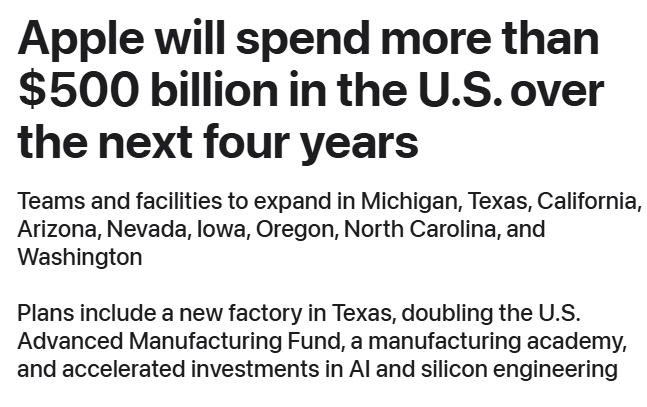We’ve been preparing for this moment since Trump’s victory, yet somehow it still came as a shock. The scale of Trump’s announcement is hard to fathom.
It is still early, and there is much to digest. But I’m starting to get a feel for winners and losers in this newly-tariffed world.
In the losers category, the most obvious one so far is Vietnam. Ever since Trump’s first round of tariffs on China in 2018, manufacturing has steadily shifted into that country.
But this move to avoid tariffs may have just backfired. On Trump’s naughty list, Vietnam stood out with a whopping 46% tariff rate. As I write this, the largest Vietnam ETF (VNM) is down about 10%.
American retailers who rely on Vietnam for production are being brought out to the woodshed. Wayfair, an online retailer which heavily relies on Vietnam and China for manufacturing, is down 24% at noon.
This one is painful to write about. Apple (AAPL) has been such a bright spot for U.S. markets over the past 20 years. One of the all-time great stock performances. But now the pain has extended to this mighty tech giant.
Apple shares are down sharply, around -8% as I write this. The market is pondering how 50% tariffs on China will affect Apple’s bottom line.
After all, Apple produces the bulk of its iPhones in China. And while the company has expanded production to India as an attempt to diversify, Trump also announced 26% tariffs on that country.
More from Bloomberg:
- India, where Apple is increasingly building iPhones and AirPods, is getting a 26% reciprocal tariff.
- Vietnam, where the company now makes some AirPods, iPads, Apple Watches and Macs, will be hit with a 46% levy.
- Malaysia, where Apple is increasingly making Mac computers, will have a 24% tariff.
- Thailand, where the company also makes some Macs, will get a 36% levy.
- Ireland, within the European Union, gets a 20% tariff. Apple produces some iMacs there.
Oof. Now we understand why, back in February, Apple announced more $500 billion of investment in U.S. manufacturing. From Apple’s official press release:

Apple clearly had some idea of what was coming. And due to the extreme nature of Trump’s plans, they made the decision to invest half a trillion dollars into the American economy.
This is the essence of Trump’s plan. Penalize foreign production, and bring jobs back home. Short-term pain, long-term gain.
From a fundamental perspective, Apple still looks expensive. Even after the 8% pullback, AAPL shares are still trading at a P/E ratio of 32 with a paltry 2% year-over-year revenue growth rate. That’s pricey, especially considering the risks ahead.
But the news that they’re planning to invest $500 billion in America is great for the country.
This is a perfect example of how the real economy now takes precedence over the stock market.
High Pain Threshold
Back in February, we discussed a Chinese golf cart company’s decision to relocate production to the U.S. after being targeted with 127%+ tariffs. At the time, I noted:
The important lesson here is that very high tariff rates were required to motivate these companies to shift production to the U.S.
So when you hear people complaining about tariffs being too high, we should recognize that in some cases, extreme measures will be required. China’s cost to manufacture goods is far lower compared to domestic markets.
Trump’s dramatic tariffs are the price required to get companies like Apple to relocate production back home.
So despite the short-term impact on markets, and 401k balances, Trump is executing his plan. He means to strongarm companies into shifting production back into the U.S. And as we have seen with Apple, Hyundai, and others, it appears to be working.
For Trump’s plan to succeed, he has to stand firm. Even if markets crash. If the market thinks he’s bluffing, the whole thing could fall apart.
So we should all be prepared for more volatility and market downside. Overall I remain bearish on U.S. stocks. As we have covered extensively, American stocks were already outrageously expensive. This could be the catalyst that sets off the inevitable crash.
Brazil: A Rare Bright Spot
My portfolio is mostly a sea of red today.
But one bright (green) spot is Brazil, which could emerge as a winner in this trade war. Trump went easy on Brazil, which escaped with the minimum 10% tariff rate.
The most popular Brazilian ETF (EWZ) is up 1% on a day when the Nasdaq is down around 5%.
Here’s some more context from the Wall Street Journal:
Brazil Looks Like a Winner in the Global Trade War
The preparations reflect a trade relationship between Brazil and China that has expanded significantly in recent years. Rich in beef, iron ore and oil, Brazil has raw materials that China’s vast population needs. China, meanwhile, has capital that Latin America’s biggest economy needs to build much-needed infrastructure.
At the same time, Brazil sees opportunities to boost exports to the U.S. and to other countries that are being hit by Trump’s tariffs, which his administration is planning to expand for an array of trading partners on Wednesday.
We highlighted Brazil as a cheap, high-yield opportunity last month in Brazilian Stocks Offer 8% Yields at 8x Earnings.
The country’s stock market remains dirt cheap, and considering the fact that Brazil is a likely beneficiary of the trade war, I remain long and will likely add to my EWZ position in the coming days.
Change of this magnitude inevitably brings opportunity, and we’ll keep looking for ways to play it. Expect a detailed analysis on what this all means for gold and silver soon (excellent buying opportunities may present themselves shortly).















